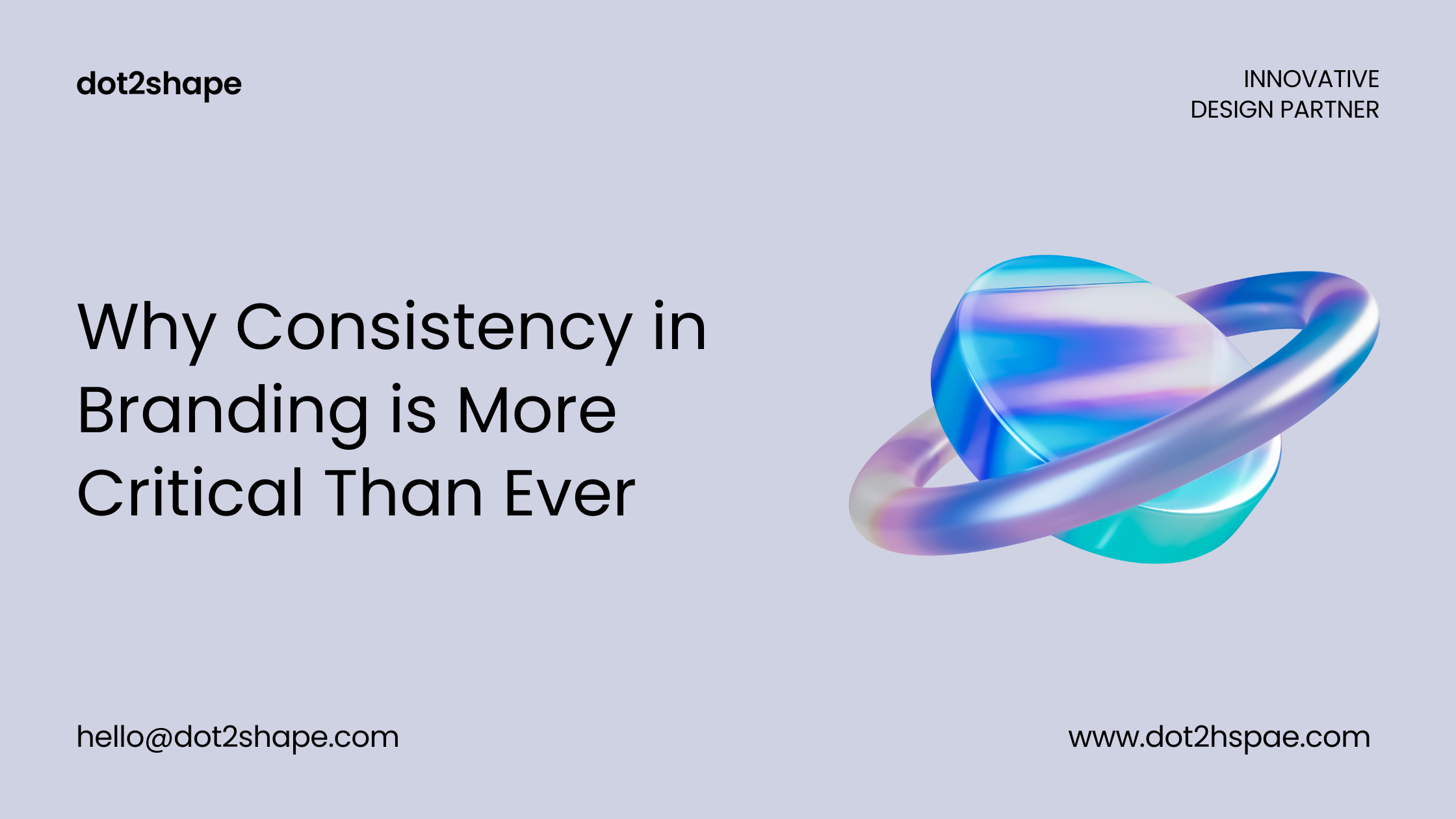In my 15+ years of product designing, UI/UX, and brand identity strategy, I’ve helped enterprises, startups, and B2C businesses across the USA, UAE, KSA, and EU. If there’s one common challenge I’ve seen destroy customer trust, it’s inconsistent branding.
In fact, Lucidpress research shows that consistent branding can increase revenue by 33% or more. And yet, many businesses fail to unify their visual coherence, cohesive messaging, and cross-platform branding.
At Dot2Shape®, we’ve designed 200+ projects globally, from real estate websites in Dubai to enterprise product launches in the United States. The lesson we’ve learned?
Here is the breaks down why consistency matters more than ever, how to achieve it, and how it directly drives measurable results for your business.
Brand consistency is not optional anymore — it’s survival.
The Problem: When Brand Consistency Fails
Let’s get real. Inconsistent branding costs you more than just aesthetics. Here’s what I’ve personally seen:
- Brand Confusion: One client’s website screamed “luxury,” but their ads looked like generic templates. Result? Customers didn’t know what to expect.
- Trust Erosion: A fintech startup in London had different tones on LinkedIn and email marketing. Prospects wondered if it was the same company.
- Wasted Marketing Spend: Without consistency, ad clicks didn’t convert because users landed on a mismatched website experience.
- Lost Recognition: If your logo, colors, and voice keep changing, your audience won’t remember you — and they’ll choose a competitor who feels familiar.
💡 From my experience: A UAE realtor we worked with struggled because their property brochures looked outdated compared to their polished digital ads. After unifying their design system, they closed 41% more deals in 90 days.
Why Consistency in Branding is More Critical Than Ever
1. Digital Noise is Deafening
Customers today see 10,000+ brand messages daily. Inconsistent brands vanish into the noise. Consistency, on the other hand, builds quick brand recognition.
2. Cross-Platform Branding is the New Norm
From Instagram reels to LinkedIn ads to enterprise product demos, your brand needs to look and sound the same everywhere. Otherwise, prospects question your reliability.
3. Trust = Repetition
According to Forbes, it takes 5–7 touchpoints for customers to remember a brand. Consistency ensures every touchpoint reinforces trust instead of diluting it.
4. Global Expansion Demands Identity Unity
Expanding into the USA, UAE, KSA, and EU? While you can adapt campaigns to local cultures, your core brand DNA must remain intact across markets.
5. AI + Automation Spread Inconsistencies Faster
In the age of AI-driven campaigns and auto-publishing tools, even small misalignments can go viral. Clear brand guidelines prevent this.
The Dot2Shape Framework for Brand Consistency
Having worked with enterprise product designers, startups, and B2C brands, here’s the proven framework I recommend:
Step 1: Define Your Brand Identity Strategy
- Mission, vision, and values
- Tone of voice (formal, casual, authoritative, approachable)
- Unique value proposition (what makes you different)
📌 Example:
A US-based SaaS client we worked with positioned themselves as “problem solver designers.” By clarifying their brand promise early, their messaging aligned across all channels.
Step 2: Create a Brand Style Guide
- Logo usage (sizes, spacing, color variations)
- Color palette & typography rules
- Photography style (e.g., luxury, minimalist, playful)
- Social media and email templates
📌 At Dot2Shape, we provide interactive brand guidelines so teams across offices in New York, Dubai, or Riyadh apply the same identity flawlessly.
Step 3: Train Teams for Cohesion
- Run quarterly brand audits
- Create onboarding modules for new hires
- Align marketing, sales, and support under one tone
Step 4: Use Tools for Visual Coherence
- Figma libraries for product designers
- Canva brand kits for non-designers
- Frontify or Brandfolder for asset management
Step 5: Audit and Evolve Regularly
- Every 6 months, compare your channels
- Gather customer feedback on clarity and recognition
Update guidelines for new platforms (e.g., TikTok, Threads)
Implementation Guidance: How to Get Started Today
You don’t need a six-month project to start building consistency.
Here’s what you can do this week:
- Audit your channels: Check if your website, LinkedIn, Instagram, and email look and sound unified.
- Standardize your visuals: Pick 2–3 fonts, 2–3 brand colors, and lock them in.
- Write a tone guide: Decide if you’ll speak casually or professionally — and stick to it.
- Centralize assets: Keep all brand files in a shared folder.
- Monitor KPIs: Track brand recognition, engagement rates, and conversion consistency.
🚫 Avoid these pitfalls:
- Overcomplicating guidelines (no one will follow them)
- Ignoring mobile-first experiences
- Copying competitors instead of defining your DNA
Social Proof: Results From Consistency
At Dot2Shape®, consistency has directly translated into measurable ROI for our clients:
- UAE Real Estate Firm: Increased conversions by 41% after aligning website + brochures.
- California SaaS Startup: Doubled engagement in 3 months after unifying social and app design.
Luxury Retail in KSA: Achieved 30% YoY sales growth by syncing in-store visuals with e-commerce branding.
FAQ: Branding Consistency Explained
1. Why is brand consistency important for small businesses?
Because trust and recognition help you compete with larger players — without huge ad budgets.
2. How does inconsistent branding affect customer trust?
It signals unreliability. If your design, tone, and visuals don’t match, prospects doubt your credibility.
3. What’s included in a brand style guide?
Logos, fonts, colors, tone of voice, and visual rules — everything your team needs to stay on-brand.
4. How often should I update my brand guidelines?
Every 6–12 months, or when launching in new markets.
5. Can branding be consistent yet localized?
Yes. Your core identity stays the same, while visuals adapt to cultural preferences.
6. Which tools help maintain brand identity strategy?
Figma, Canva Brand Kits, Frontify, and automated scheduling tools.
7. What’s the ROI of brand consistency?
From my experience, expect higher trust, lower bounce rates, and conversion increases between 20–40%.
8. Is this only for enterprise brands?
No. SMEs and startups benefit even more since recognition helps them scale faster.
9. How does Dot2Shape ensure brand consistency?
We deliver end-to-end design systems, interactive brand guides, and cross-platform audits tailored for each client.10. How long before I see results?
Typically within 3–6 months, depending on your marketing intensity.
Conclusion: Consistency is Your Competitive Edge
Brand consistency isn’t just design polish — it’s your business growth engine. In today’s saturated, multi-platform world, consistency in visuals, messaging, and identity is what builds brand trust, recognition, and revenue growth.
At Dot2Shape®, we’ve helped brands across the USA, UAE, KSA, and EU unify their identity and achieve tangible results.
👉 If you’re ready to elevate your business with a cohesive brand identity strategy, contact Dot2Shape today. Let’s make your brand unforgettable.


